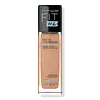Estée Lauder Double Wear Stay-in-Place Foundation Versus Maybelline Fit Me Matte & Poreless Foundation
What's inside
What's inside
 Key Ingredients
Key Ingredients

 Benefits
Benefits

 Concerns
Concerns

 Ingredients Side-by-side
Ingredients Side-by-side

Water
Skin ConditioningCyclopentasiloxane
EmollientTrimethylsiloxysilicate
EmollientPEG/PPG-18/18 Dimethicone
EmulsifyingButylene Glycol
HumectantTribehenin
EmollientPolyglyceryl-3 Diisostearate
EmulsifyingMagnesium Sulfate
Tocopheryl Acetate
AntioxidantPolymethylsilsesquioxane
Methicone
EmollientLaureth-7
EmulsifyingXanthan Gum
EmulsifyingAlumina
AbrasiveSodium Dehydroacetate
PreservativeDisteardimonium Hectorite
StabilisingCellulose Gum
Emulsion StabilisingPropylene Carbonate
SolventPentaerythrityl Tetra-Di-T-Butyl Hydroxyhydrocinnamate
AntioxidantPhenoxyethanol
PreservativeIron Oxides
Mica
Cosmetic ColorantCI 77891
Cosmetic ColorantWater, Cyclopentasiloxane, Trimethylsiloxysilicate, PEG/PPG-18/18 Dimethicone, Butylene Glycol, Tribehenin, Polyglyceryl-3 Diisostearate, Magnesium Sulfate, Tocopheryl Acetate, Polymethylsilsesquioxane, Methicone, Laureth-7, Xanthan Gum, Alumina, Sodium Dehydroacetate, Disteardimonium Hectorite, Cellulose Gum, Propylene Carbonate, Pentaerythrityl Tetra-Di-T-Butyl Hydroxyhydrocinnamate, Phenoxyethanol, Iron Oxides, Mica, CI 77891
Water
Skin ConditioningCyclohexasiloxane
EmollientNylon-12
Isododecane
EmollientAlcohol Denat.
AntimicrobialCyclopentasiloxane
EmollientPEG-10 Dimethicone
Skin ConditioningCetyl PEG/PPG-10/1 Dimethicone
EmulsifyingPEG-20
HumectantPolyglyceryl-4 Isostearate
EmulsifyingDisteardimonium Hectorite
StabilisingPhenoxyethanol
PreservativeMagnesium Sulfate
Disodium Stearoyl Glutamate
CleansingHdi/Trimethylol Hexyllactone Crosspolymer
Titanium Dioxide
Cosmetic ColorantMethylparaben
PreservativeAcrylates Copolymer
Tocopherol
AntioxidantButylparaben
MaskingAluminum Hydroxide
EmollientAlumina
AbrasiveSilica
AbrasiveGlycerin
HumectantCI 77891
Cosmetic ColorantCI 77491
Cosmetic ColorantCI 77492
Cosmetic ColorantCI 77499
Cosmetic ColorantCeramide AP
Skin ConditioningWater, Cyclohexasiloxane, Nylon-12, Isododecane, Alcohol Denat., Cyclopentasiloxane, PEG-10 Dimethicone, Cetyl PEG/PPG-10/1 Dimethicone, PEG-20, Polyglyceryl-4 Isostearate, Disteardimonium Hectorite, Phenoxyethanol, Magnesium Sulfate, Disodium Stearoyl Glutamate, Hdi/Trimethylol Hexyllactone Crosspolymer, Titanium Dioxide, Methylparaben, Acrylates Copolymer, Tocopherol, Butylparaben, Aluminum Hydroxide, Alumina, Silica, Glycerin, CI 77891, CI 77491, CI 77492, CI 77499, Ceramide AP
 Reviews
Reviews

Ingredients Explained
These ingredients are found in both products.
Ingredients higher up in an ingredient list are typically present in a larger amount.
Alumina is another name for the compound aluminum oxide. It is used as a thickener, absorbent, and abrasive.
As an absorbent, alumina can give a mattifying effect. It is used in mineral sunscreens to help coat nano-sized filters, such as titanium dioxide. By increasing the size of the UV filters, these ingredients stay on the skin for a longer time. By coating small sized ingredients, alumina helps thicken a product.
Alumina may be used as an abrasive, or exfoliant.
Alumina is naturally occurring in the mineral corundum. Certain varieties of corundum create rubies and sapphires. Corundum is also the crystalline form of alumina.
Learn more about AluminaCi 77891 is a white pigment from Titanium dioxide. It is naturally found in minerals such as rutile and ilmenite.
It's main function is to add a white color to cosmetics. It can also be mixed with other colors to create different shades.
Ci 77891 is commonly found in sunscreens due to its ability to block UV rays.
Learn more about CI 77891Cyclopentasiloxane, or D5, is a silicone used to improve texture of products and trap moisture.
D5 is considered lightweight and volatile. Volatile means it evaporates quickly after application. Once evaporated, D5 leaves a thin barrier that helps keep skin hydrated.
It is also an emollient. Emollients help soften the skin and prevent water loss. Silicones create a silky texture in products. D5 helps other ingredients become more spreadable.
Studies show D5 is safe to use in skincare products. We recommend speaking with a skincare professional if you have concerns.
Learn more about CyclopentasiloxaneDisteardimonium Hectorite comes from the clay mineral named hectorite. It is used to add thickness to a product.
It can also help stabilize a product by helping to disperse other ingredients.
Hectorite is a rare, white clay mineral.
Learn more about Disteardimonium HectoriteMagnesium Sulfate is a salt. More specifically, it is an epsom salt, or the bath salt used to help relieve muscle aches.
Despite having ‘sulfate’ in the name, it isn’t a surfactant or cleansing agent like sodium lauryl sulfate. Unlike those sulfates, magnesium sulfate doesn’t have the same cleansing or foaming properties (it's simply a type of salt).
In cosmetics, Magnesium Sulfate is used to thicken a product or help dilute other solids. It is a non-reactive and non-irritating ingredient.
One study shows magnesium deficiency may lead to inflammation of the skin. Applying magnesium topically may help reduce inflammation.
You can find this ingredient in sea water or mineral deposits.
Learn more about Magnesium SulfatePhenoxyethanol is a preservative that has germicide, antimicrobial, and aromatic properties. Studies show that phenoxyethanol can prevent microbial growth. By itself, it has a scent that is similar to that of a rose.
It's often used in formulations along with Caprylyl Glycol to preserve the shelf life of products.
Water. It's the most common cosmetic ingredient of all. You'll usually see it at the top of ingredient lists, meaning that it makes up the largest part of the product.
So why is it so popular? Water most often acts as a solvent - this means that it helps dissolve other ingredients into the formulation.
You'll also recognize water as that liquid we all need to stay alive. If you see this, drink a glass of water. Stay hydrated!
Learn more about Water